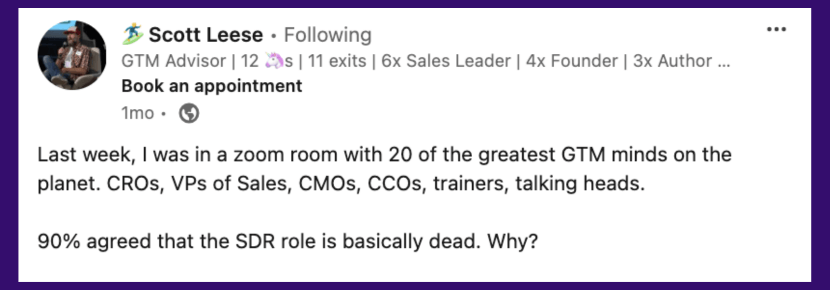If you’ve been on LinkedIn lately, you may have heard about the supposed “death of the SDR.” When someone influential like Scott Leese says it, people tend to listen. With AI and sales automation tools rapidly advancing – not to mention decision-maker fatigue from endless sales conversations– some claim that SDR role is destined to […]
If you’ve been on LinkedIn lately, you may have heard about the supposed “death of the SDR.” When someone influential like Scott Leese says it, people tend to listen.
With AI and sales automation tools rapidly advancing – not to mention decision-maker fatigue from endless sales conversations– some claim that SDR role is destined to go the way of the dodo.
But hold on, let’s take a step back. It’s not that the sales development role is dead, it’s just going through a pretty major evolutionary shift. The strategies and tactics that used to work for SDRs just aren’t cutting it anymore, so it’s time to adapt. That way, SDRs can do more than just survive in the competitive new sales world– they can thrive.
The old SDR playbook is a dinosaur
Let’s take a moment to be honest: the traditional SDR approach of blindly blasting out robotic cold emails and auto-dialing anyone who might possibly have a slight chance of being interested (otherwise known as spray and pray) is just noise at this point. Prospects are overwhelmed with generic spam from sales reps they don’t know or care about (harsh, but true).
No one enjoys getting spammed or feeling like a spammer. A high volume approach is just a waste of everyone’s time – especially the sales rep’s.
The response rates on automated cadences are dismal– think around 1- 5% – compared to thoughtful, personalized outreach (which you can still do at scale using hyper-segmented lists).
Plus, buyers today are way more educated than in the past. 96% of them will do their own research before talking to a sales rep. They can sniff out lazy, robotic sales tactics from a mile away and tune you out entirely. Just dropping a low-effort cold pitch into their inbox isn’t going to cut it.
Hands-off sequences without personalization, calling number after number without knowing why a specific prospect should care… at this point, those tactics are downright prehistoric.
With these tactics, it’s no wonder that more than half of SDRs missed their quotas in 2023.
The new SDR model: smarter, more targeted outreach
So the typical SDR workflow doesn’t work… now what? Well, chances are, you’ve already seen the ways that sales strategies have been shifting recently.
All you have to do is evolve with the times. Sales has always been about survival of the fittest, after all.
The SDR role isn’t dead, and outreach isn’t dead either. It’s all about the way you do it.
The new way to succeed? Use multiple data signals across channels to hyper-personalize your outreach. The more info you layer, the more relevant (and therefore more effective) you can make your targeting and messaging.
Gone are the days where fitting your ideal customer profile (ICP) was enough to qualify a prospect for cold outreach. Stack buying signals to cut through the noise and pinpoint what your prospect is interested in.
These signals can be things like:
- Job changes
- Company news/events (like a recent funding round)
- Tech stack changes
- Website visits
- Social media activity (comments and posts)
- Spikes in intent data
By stacking these disparate data points, you can create some laser-targeted outreach and packed with relevant insights specific to each prospect. This is the way to actually drive conversations that resonate instead of just contributing to the noise. It’s all about offering real value to your prospects.
Inbound still isn’t enough, so take a blended approach
Some would argue that inbound is the future and outbound is dead (in case you haven’t noticed, people like to declare things “dead” on social media). But that’s a short-sighted exaggeration said to drum up engagement. While inbound leads are great, they’ll never be enough to consistently fill your pipeline.
The SDRs of the future need to master a blended outbound+inbound model. They’ll use intent data and other signals to proactively identify prospective buyers entering new cycles. Then they’ll take on creative, multi-channel plays to slide their solutions into that prospect’s journey at precisely the right time.
To adapt and survive, you need to do things a little differently moving forward. In addition to reaching out, you’ll have to work at building your own personal network and generate inbound interest through social content. 95% of B2B buying decisions are significantly influenced by content – and that includes the content that SDRs share out on their own profiles.
That means SDRs need to start social selling (and no, that doesn’t mean connecting on LinkedIn and sending cold InMail without any further interaction), attending industry events, asking for referrals, and taking advantage of the latest technology available…all on top of still doing cold outreach.
It’s not simple, but this is the kind of complex work that effective prospecting is going to require in the future. It’s a blended model of attracting prospects while engaging your ideal audiences with surgical precision, thanks to data signals. The old rigid lines between inbound and outbound are fading, and natural selection demands that the SDRs who make it straddle that line.
How SDR leaders can keep their teams ahead of the curve
Leaders of SDR teams are rightfully worried about sinking performance numbers and the looming “death of the SDR.” Those who want to stay ahead of the evolutionary curve would be wise to:
- Double down on training for more sophisticated, multi-channel prospecting tactics beyond basic cold outreach.
- Provide reps with access to the latest sales intelligence tools so they can use multiple data signals to prioritize and personalize their efforts.
- Prune bloated structures and processes that create redundancies so you’re not cannibalizing your own efforts.
- Focus more on quality conversations and pipeline contributed rather than metrics that are about pure volume of activity.
The bottom line
It may be the new hot thing to declare that the SDR role is dead, but like most inflammatory statements, that’s an oversimplification. The role isn’t dying, but evolving in parallel with other major shifts in buying behavior and sales technology.
Reps who learn to leverage data insights, blend inbound and outbound tactics, and offer hyper-personalized relevance will thrive in this new era of smarter selling. Those who cling to stale spam tactics will be the real dinosaurs facing extinction.
The future of sales belongs to those who embrace change.
If you’re ready to change the way that you function as an SDR or SDR leader, consider giving Lusha a spin. We’re a sales intelligence tool with dynamic, fresh data, plus intelligent buying signals like intent, job change alerts, company funding information, and tech stack insights. You can start for free today and thrive in this new era of selling.




